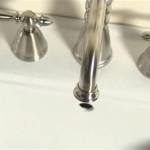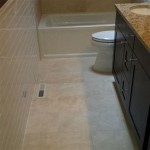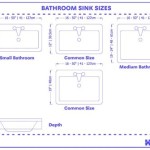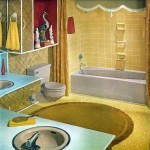Why Does My Bathroom Get Moldy?
Mold growth in bathrooms is a prevalent household issue. The warm, humid conditions often present in bathrooms create an ideal environment for mold spores to thrive. Understanding the factors contributing to mold development in this space is crucial for effective prevention and remediation.
The Role of Moisture in Mold Formation
Moisture is the primary catalyst for mold growth. Bathrooms, by their very nature, are regularly exposed to significant levels of moisture. Showers, baths, and even handwashing generate steam and water droplets that linger in the air and settle on surfaces. This persistent dampness provides the necessary hydration for mold spores to germinate and multiply.
Inadequate ventilation exacerbates the moisture problem. When steam and water vapor are not effectively removed from the bathroom environment, they condense on walls, ceilings, and other surfaces. This condensation creates a breeding ground for mold. The longer these surfaces remain damp, the greater the opportunity for mold to establish itself and spread.
Leaks, whether from plumbing fixtures, damaged tiles, or roof issues, introduce additional sources of moisture. Even small, slow leaks can contribute to hidden mold growth within walls, under flooring, or behind cabinets. These hidden infestations can be difficult to detect until the mold becomes visible or emits a musty odor.
Furthermore, certain building materials are more susceptible to moisture retention than others. Porous materials like drywall, grout, and wood readily absorb moisture, providing a substrate for mold to colonize. These materials require extra attention to ensure they are properly sealed and maintained to minimize moisture absorption.
Inadequate Ventilation and Air Circulation
Ventilation plays a critical role in controlling moisture levels in the bathroom. An effective ventilation system removes humid air and replaces it with drier air, reducing the opportunity for condensation and mold growth. However, many bathrooms have inadequate or improperly functioning ventilation.
Bathroom fans are the most common form of ventilation. These fans are designed to exhaust moist air to the outside. However, if the fan is undersized for the bathroom's square footage, if it is not used consistently during and after showers or baths, or if it is improperly vented, it will not effectively remove moisture. Fans should be correctly sized and regularly cleaned to ensure optimal performance.
Natural ventilation, such as opening a window, can also help to reduce moisture levels. However, this is not always practical, especially during colder months or in bathrooms without windows. Additionally, natural ventilation relies on favorable weather conditions and may not be sufficient to remove moisture quickly enough.
Air circulation is also important. Stagnant air allows moisture to accumulate on surfaces. Ensuring adequate airflow throughout the bathroom, even when the ventilation system is not in use, can help to keep surfaces drier and less conducive to mold growth. This can be achieved by keeping the bathroom door slightly ajar or by using a small fan to circulate air.
The absence of proper ventilation can lead to a build-up of humidity levels. High humidity provides the conducive environment for the rapid growth of mold and mildew, particularly in areas prone to moisture build-up, such as around the shower, sink, and toilet areas.
Organic Materials: The Food Source for Mold
Mold requires a food source to grow. In bathrooms, a variety of organic materials can serve as this food source. These materials include soap scum, body oils, hair, dust, and even the paper backing on drywall.
Soap scum, which is a byproduct of soap reacting with hard water, is a particularly common food source for mold. It accumulates on shower walls, doors, and fixtures, providing a readily available nutrient source for mold spores. Regular cleaning with appropriate cleaning products is essential to remove soap scum and prevent mold growth.
Body oils and hair, which are shed during showers and baths, also contribute to the accumulation of organic matter in the bathroom. These materials can become trapped in grout lines, drains, and other hard-to-reach areas, providing a food source for mold. Regular cleaning and maintenance, including drain cleaning, are necessary to remove these organic materials.
Even dust, which is ubiquitous in any environment, can contain organic matter that mold can feed on. Dust accumulates on surfaces throughout the bathroom, providing a substrate for mold to colonize. Regular dusting and cleaning of surfaces can help to remove this food source and prevent mold growth.
Additionally, some building materials contain organic components that can serve as a food source for mold. For example, the paper backing on drywall is made from cellulose, which is a readily digestible food source for mold. If drywall becomes wet, the paper backing can become a prime location for mold growth. This is particularly problematic in bathrooms where drywall is exposed to moisture.
Temperature and Humidity Levels
Mold thrives in warm, humid environments. Bathrooms, which are often warmer and more humid than other rooms in the house, provide ideal conditions for mold growth. Maintaining appropriate temperature and humidity levels can help to inhibit mold growth.
Warm temperatures accelerate mold growth. Mold spores germinate and multiply more rapidly at higher temperatures. While it is not always possible to control the temperature in the bathroom, avoiding excessively high temperatures can help to slow down mold growth.
High humidity levels provide the necessary moisture for mold to thrive. Relative humidity levels above 60% create a conducive environment for mold growth. Using a dehumidifier can help to reduce humidity levels in the bathroom, especially in areas with poor ventilation.
Monitoring humidity levels with a hygrometer can help to identify potential problems. If humidity levels are consistently high, it may indicate a need for improved ventilation or other measures to control moisture. Addressing high humidity levels promptly can help to prevent mold growth before it becomes a serious problem.
Proper insulation can also help to control temperature and humidity levels. Insulating walls and pipes can prevent condensation and reduce the likelihood of mold growth. This is particularly important in bathrooms that are located in colder climates or that have poor insulation.
Surface Materials and Their Susceptibility
The type of surface material used in the bathroom significantly impacts mold growth susceptibility. Certain materials are highly porous and absorbent, making them more prone to mold colonization. Other materials are naturally mold-resistant or can be treated to enhance their resistance.
Grout, a porous material commonly used in tile installations, is particularly susceptible to mold growth. Grout lines provide a rough surface that traps moisture and organic matter, creating an ideal environment for mold. Regular cleaning and sealing of grout lines can help to prevent mold growth.
Caulk, another common material used in bathrooms, can also be susceptible to mold growth. Caulk is used to seal gaps around tubs, showers, and sinks, preventing water from penetrating behind walls. However, caulk can crack and deteriorate over time, allowing water to penetrate and creating a breeding ground for mold. Regular inspection and replacement of damaged caulk is essential.
Porous tiles, such as unglazed ceramic tiles, can also absorb moisture and provide a substrate for mold growth. Choosing non-porous tiles, such as porcelain tiles, can help to reduce the risk of mold growth. Sealing porous tiles can also help to prevent moisture absorption.
Wood surfaces, such as cabinets and trim, are also susceptible to mold growth. Wood is a natural organic material that provides a food source for mold. Sealing or painting wood surfaces can help to protect them from moisture and prevent mold growth. Using mold-resistant paints and sealants can provide additional protection.
Cleaning Habits and Frequency
Regular cleaning is crucial in preventing mold growth in the bathroom. Neglecting cleaning allows soap scum, body oils, and other organic matter to accumulate, providing a food source for mold. Consistent cleaning helps to remove these materials and inhibit mold growth.
The frequency of cleaning depends on the usage of the bathroom and the presence of other factors that contribute to mold growth. Bathrooms that are used frequently or that have poor ventilation may require more frequent cleaning than bathrooms that are used less often or that have good ventilation.
Using appropriate cleaning products is also important. Cleaning products that contain bleach or other antifungal agents can help to kill mold spores and prevent them from growing. However, it is important to use these products safely and to follow the manufacturer's instructions carefully.
Pay particular attention to areas that are prone to moisture accumulation, such as shower walls, doors, and fixtures. These areas should be cleaned regularly to remove soap scum and other organic matter. Grout lines and caulk should also be cleaned regularly to prevent mold growth.
In addition to regular cleaning, it is also important to address any leaks or water damage promptly. Leaks can provide a constant source of moisture that promotes mold growth. Repairing leaks and drying out wet areas quickly can help to prevent mold from establishing itself.

How To Get Rid Of Mold In Bathroom 2024 Tips From Puroclean

Ways To Prevent Mold In Bathrooms Forbes Home

Why Is There Mold On My Bathroom A J Property Restoration Dk

What To Know About Bathroom Mold And When You Should Worry

Bathroom Mold How To Kill On Ceiling

Why Is There Black Mold On My Bathroom Ceiling Medics

Mold In Toilet How To Remove

What Do About Black Mold In The Bathroom Bob Vila

Bathroom Ceiling Mold Removal When To Clean Call Branch Environmental

How To Get Rid Of Mold On Your Bathroom Ceiling Aqa
Related Posts







